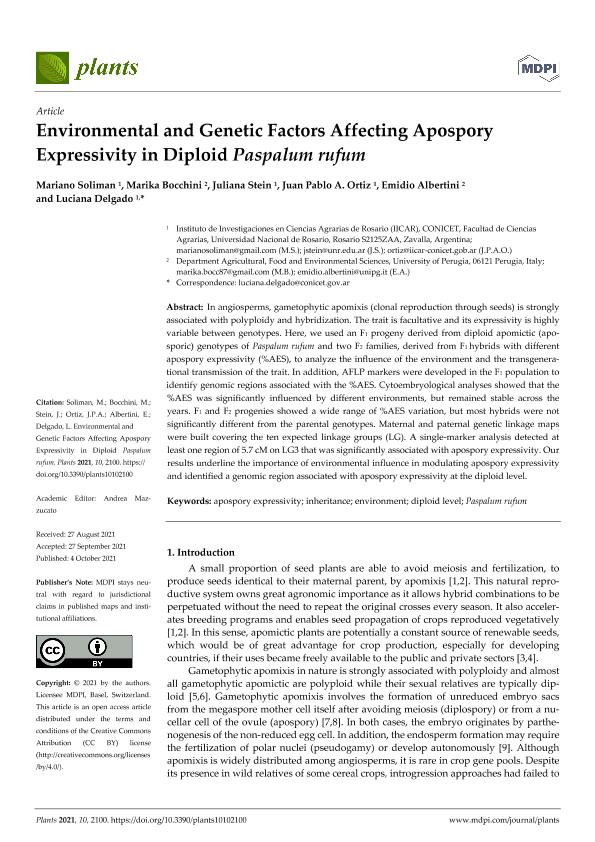Artículo
Environmental and genetic factors affecting apospory expressivity in diploid paspalum rufum
Soliman, Mariano ; Bocchini, Marika; Stein, Juliana
; Bocchini, Marika; Stein, Juliana ; Ortiz, Juan Pablo Amelio
; Ortiz, Juan Pablo Amelio ; Albertini, Emidio; Delgado Benarroch, Luciana
; Albertini, Emidio; Delgado Benarroch, Luciana
 ; Bocchini, Marika; Stein, Juliana
; Bocchini, Marika; Stein, Juliana ; Ortiz, Juan Pablo Amelio
; Ortiz, Juan Pablo Amelio ; Albertini, Emidio; Delgado Benarroch, Luciana
; Albertini, Emidio; Delgado Benarroch, Luciana
Fecha de publicación:
10/2021
Editorial:
Multidisciplinary Digital Publishing Institute
Revista:
Plants
e-ISSN:
2223-7747
Idioma:
Inglés
Tipo de recurso:
Artículo publicado
Clasificación temática:
Resumen
In angiosperms, gametophytic apomixis (clonal reproduction through seeds) is strongly associated with polyploidy and hybridization. The trait is facultative and its expressivity is highly variable between genotypes. Here, we used an F1 progeny derived from diploid apomictic (aposporic) genotypes of Paspalum rufum and two F2 families, derived from F1 hybrids with different apospory expressivity (%AES), to analyze the influence of the environment and the transgenerational transmission of the trait. In addition, AFLP markers were developed in the F1 population to identify genomic regions associated with the %AES. Cytoembryological analyses showed that the %AES was significantly influenced by different environments, but remained stable across the years. F1 and F2 progenies showed a wide range of %AES variation, but most hybrids were not significantly different from the parental genotypes. Maternal and paternal genetic linkage maps were built covering the ten expected linkage groups (LG). A single-marker analysis detected at least one region of 5.7 cM on LG3 that was significantly associated with apospory expressivity. Our results underline the importance of environmental influence in modulating apospory expressivity and identified a genomic region associated with apospory expressivity at the diploid level.
Palabras clave:
APOSPORY EXPRESSIVITY
,
DIPLOID LEVEL
,
ENVIRONMENT
,
INHERITANCE
,
PASPALUM RUFUM
Archivos asociados
Licencia
Identificadores
Colecciones
Articulos(IICAR)
Articulos de INST. DE INVESTIGACIONES EN CIENCIAS AGRARIAS DE ROSARIO
Articulos de INST. DE INVESTIGACIONES EN CIENCIAS AGRARIAS DE ROSARIO
Citación
Soliman, Mariano; Bocchini, Marika; Stein, Juliana; Ortiz, Juan Pablo Amelio; Albertini, Emidio; et al.; Environmental and genetic factors affecting apospory expressivity in diploid paspalum rufum; Multidisciplinary Digital Publishing Institute; Plants; 10; 10; 10-2021; 1-25
Compartir
Altmétricas



